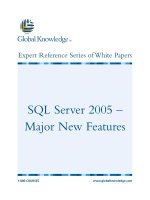Expert SQL Server 2005 Development - Introduction
Bạn đang xem bản rút gọn của tài liệu. Xem và tải ngay bản đầy đủ của tài liệu tại đây (107.24 KB, 2 trang )
Introduction
W
orking with SQL Server on project after project, I find myself solving the same types of
problems again and again. The solutions differ slightly from case to case, but they often share
something in common—code patterns, logical processes, or general techniques. Every time
I work on a customer’s software, I feel like I’m building on what I’ve done before, creating a greater
set of tools that I can apply to the next project and the next after that. Whenever I start feeling
like I’ve gained mastery in some area, I’ll suddenly learn a new trick and realize that I really
don’t know anything at all—and that’s part of the fun of working with such a large, flexible
product as SQL Server.
This book, at its core, is all about building your own set of tools from which you can draw
inspiration as you work with SQL Server. I try to explain not only the hows of each concept
described herein, but also the whys. And in many examples throughout the book, I attempt to
delve into the process I took for finding what I feel is the optimal solution. My goal is to share
with you how I think through problems. Whether or not you find my approach to be directly
usable, my hope is that you can harness it as a means by which to tune your own development
methodology.
This book is arranged into three logical sections. The first four chapters deal with software
development methodologies as they apply to SQL Server. The next three chapters get into
advanced features specific to SQL Server. And the final four chapters are more architecturally
focused, delving into specific design and implementation issues around some of the more dif-
ficult topics I’ve encountered in past projects.
Chapters 1 and 2 aim to provide a framework for software development in SQL Server. By
now, SQL Server has become a lot more than just a DBMS, yet I feel that much of the time it’s
not given the respect it deserves as a foundation for application building. Rather, it’s often
treated as a “dumb” object store, which is a shame, considering how much it can do for the
applications that use it. In these chapters, I discuss software architecture and development
methodologies, and how to treat your database software just as you’d treat any other software—
including testing it.
Software development is all about translating business problems into technical solutions,
but along the way you can run into a lot of obstacles. Bugs in your software or other components
and intruders who are interested in destroying or stealing your data are two of the main hurdles
that come to mind. So Chapters 3 and 4 deal with exception handling and security, respectively.
By properly anticipating error conditions and guarding against security threats, you’ll be able
to sleep easier at night, knowing that your software won’t break quite as easily under pressure.
Encryption, SQLCLR, and proper use of dynamic SQL are covered in Chapters 5, 6, and 7.
These chapters are not intended to be complete guides to each of these features—especially
true of the SQLCLR chapter—but are rather intended as reviews of some of the most important
things you’ll want to consider as you use these features to solve your own business problems.
Chapters 8 through 11 deal with application concurrency, spatial data, temporal data, and
graphs. These are the biggest and most complex chapters of the book, but also my favorite.
xix
CH00FMFINAL.qxd 4/20/07 4:19 PM Page xix
Data architecture is an area where a bit of creativity often pays off—a good place to sink your
teeth into new problems. These chapters show how to solve common problems using a variety
of patterns, each of which should be easy to modify and adapt to situations you might face in
your day-to-day work as a database developer.
Finally, I’d like to remind readers that database development, while a serious pursuit and
vitally important to business, should be fun! Solving difficult problems cleverly and efficiently
is an incredibly satisfying pursuit. I hope that this book helps readers get as excited about
database development as I am.
■
INTRODUCTIONxx
CH00FMFINAL.qxd 4/20/07 4:19 PM Page xx









